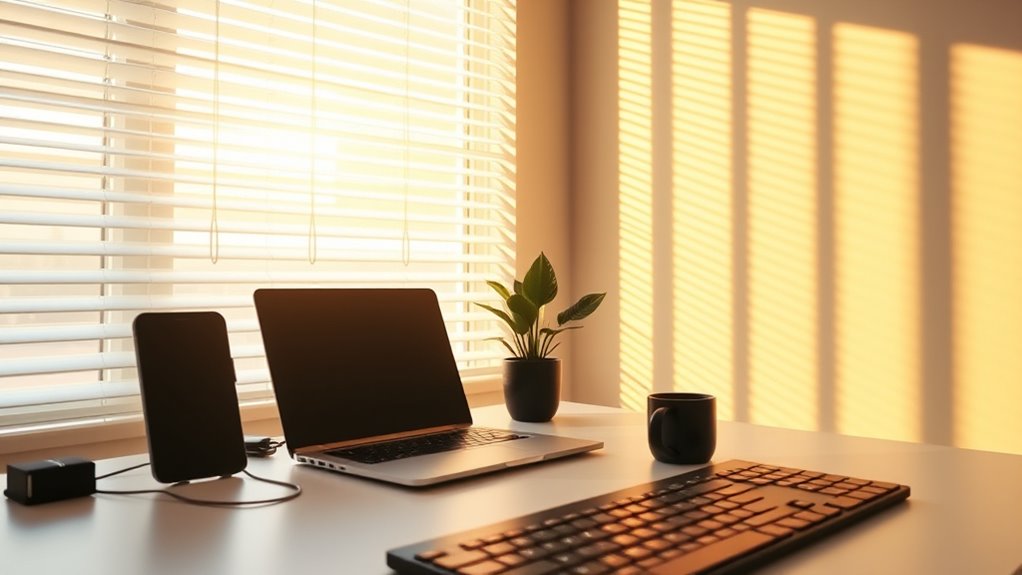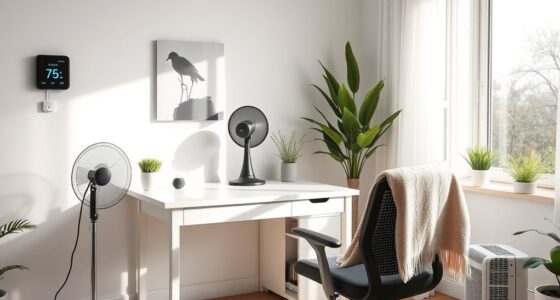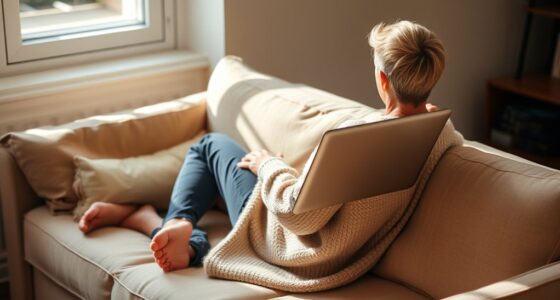Lighting directly affects your focus by influencing your brain’s alertness and mood. Natural light boosts serotonin, keeping you energized, while well-designed artificial lighting minimizes eye strain and distraction. Adjusting color temperature and brightness helps create an environment tailored to your tasks, enhancing concentration. Proper layering and fixture placement prevent glare and shadows. Want to learn how optimizing your lighting can boost your productivity even further? Keep exploring for expert tips.
Key Takeaways
- Proper lighting activates brain pathways that enhance alertness, concentration, and cognitive performance during work tasks.
- Natural light boosts mood and circadian rhythm, improving focus and reducing fatigue in home office environments.
- Bright, cool artificial lighting mimics sunlight, decreasing eye strain and increasing mental clarity for productivity.
- Layered lighting with adjustable intensity allows tailored environments that support sustained focus and comfort.
- Incorrect lighting choices, like poor placement or insufficient brightness, can cause distraction, eye strain, and reduced concentration.
The Science Behind Light and Brain Function
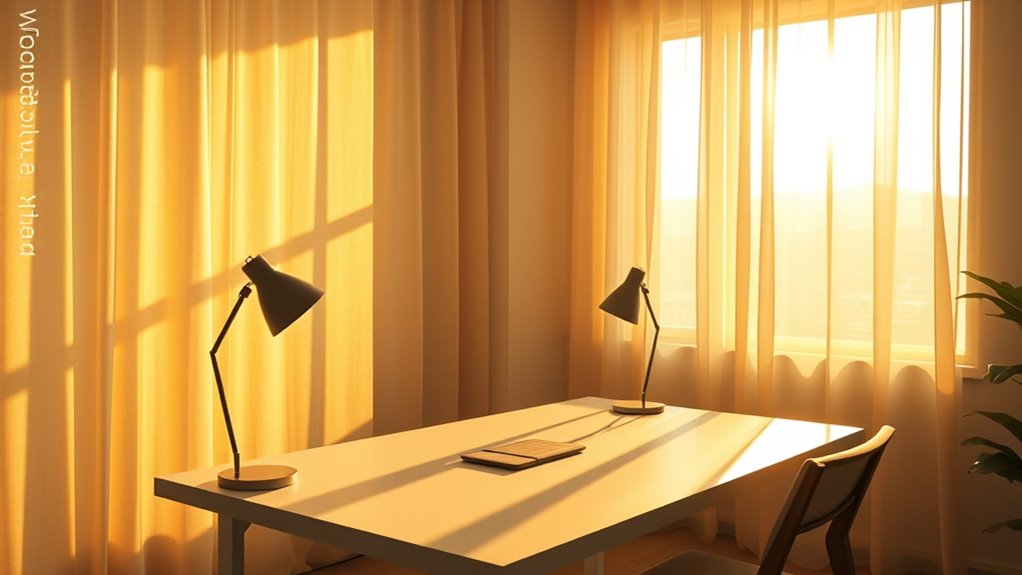
Light plays an essential role in regulating your brain’s activity, especially when it comes to focus and alertness. When you’re exposed to light, photoreceptor activation occurs in your eyes, sending signals through neural pathways to your brain. These pathways communicate the presence and intensity of light, influencing your circadian rhythms and cognitive functions. Bright, well-structured lighting stimulates these neural pathways, helping you stay alert and attentive. Conversely, dim lighting can reduce photoreceptor activation, leading to decreased neural signaling and drowsiness. Your brain responds to these light signals by adjusting levels of alertness, making lighting a key factor in maintaining focus during work. Understanding this connection highlights how essential proper lighting is for prime brain function and productivity. Additionally, research indicates that local lighting conditions can significantly impact your overall mental clarity and efficiency throughout the day.
How Natural Light Enhances Concentration
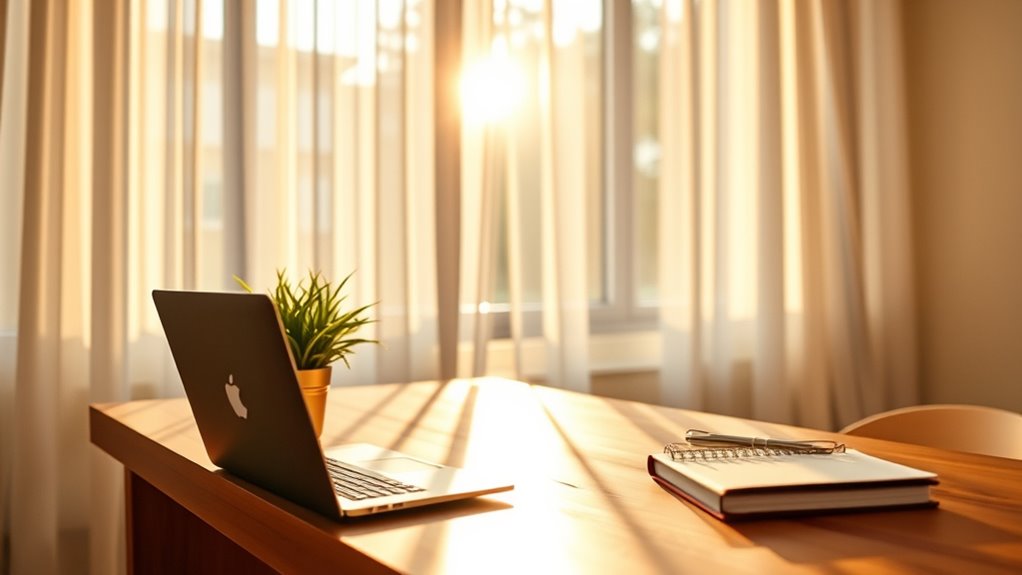
Natural light boosts your mood and keeps you alert throughout the day. It also helps regulate your circadian rhythm, so you feel more in sync with your body’s natural cycle. When your home office gets ample natural light, your focus and productivity tend to improve. Incorporating practical tools to maximize natural light can further enhance these benefits.
Mood and Alertness
When your workspace is flooded with sunlight, it’s easier to stay focused and feel motivated throughout the day. Natural light boosts your mood regulation, helping you feel more positive and less stressed. It also enhances alertness, keeping you sharp and attentive. Exposure to sunlight triggers the release of serotonin, which improves your overall mood and energy levels. Consider this table illustrating its effects: Additionally, natural light can support mindfulness practices by creating a more calming environment that encourages present-moment awareness.
Circadian Rhythm Alignment
Have you ever noticed how your energy levels fluctuate throughout the day? Natural light plays a key role in aligning your circadian rhythm, which impacts focus and overall well-being. When your circadian rhythm syncs with light patterns, your sleep hygiene improves, helping you feel more alert during work hours. Proper exposure to natural light also enhances visual comfort, reducing eye strain and fatigue. To optimize this:
- Position your workspace near windows
- Take breaks outside in daylight
- Use adjustable blinds for control
- Avoid harsh artificial lighting at night
- Keep screens at eye level for better visual comfort
- Incorporating light spectrum considerations can further improve your circadian alignment and overall productivity.
The Impact of Artificial Lighting on Productivity
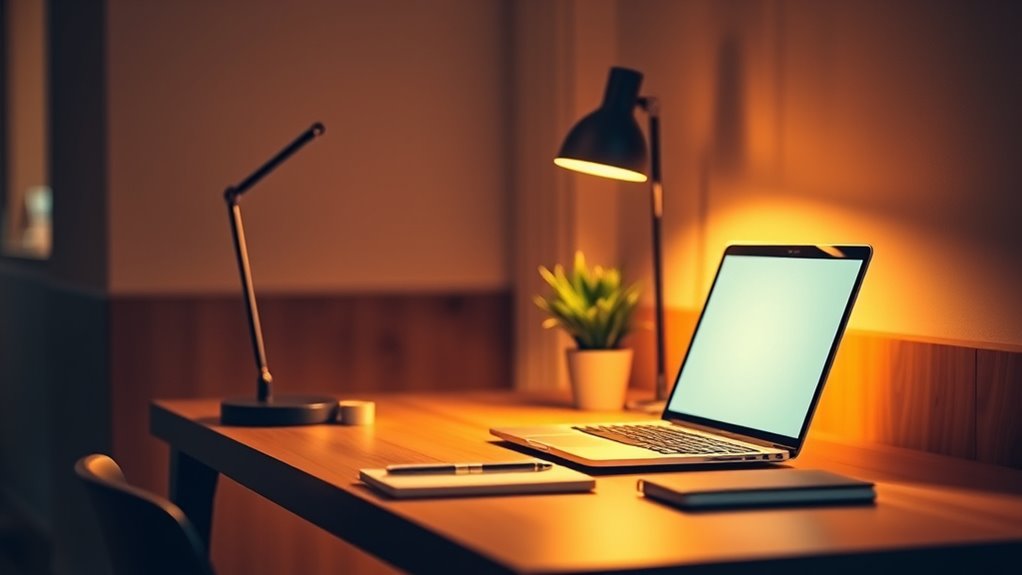
Artificial lighting plays a crucial role in shaping your productivity in a home office, especially when natural light is limited. Poor artificial lighting can cause eye strain and fatigue, reducing your focus throughout the day. Excessive or poorly directed light may contribute to light pollution, making your workspace uncomfortable and distracting. Conversely, proper lighting, like light therapy lamps, can boost alertness and mood, helping you stay engaged. Bright, well-balanced lighting mimics natural sunlight, improving concentration and reducing fatigue. By choosing the right fixtures and brightness levels, you support your body’s circadian cues and minimize glare. Additionally, air quality can influence cognitive function and overall well-being, making it an important factor to consider in creating an optimal workspace. Remember, the quality and placement of artificial light directly impact your ability to work efficiently and stay focused at home.
Color Temperature and Its Effect on Mood and Focus
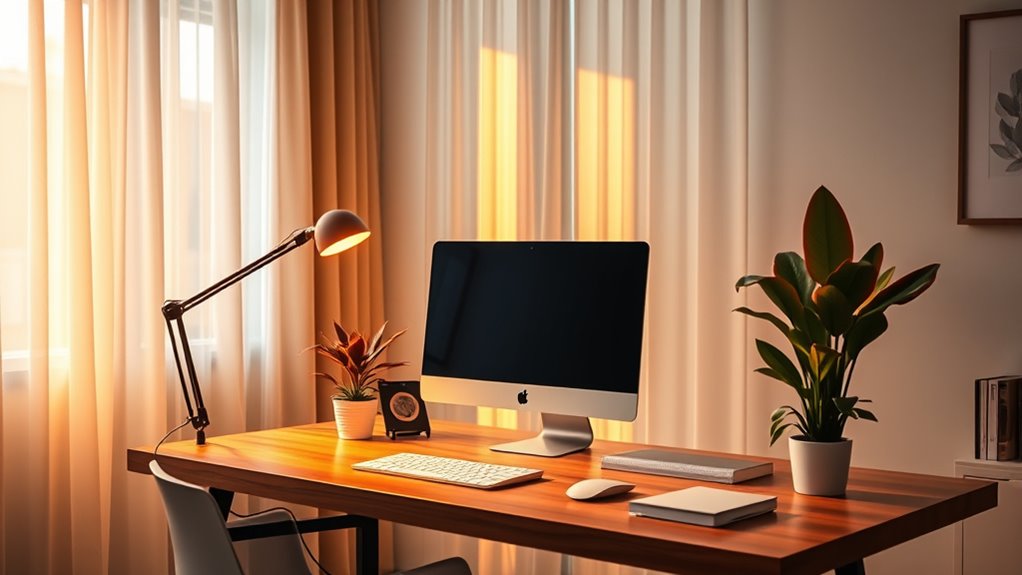
The color temperature of your lighting can considerably influence your mood and focus throughout the day. Warm light creates a cozy atmosphere that’s perfect for relaxation, while cool light energizes your mind and boosts alertness. Choosing the right brightness and color temperature helps you stay efficient and sharp during tasks. Additionally, incorporating appropriate automation in your home office lighting can optimize these effects based on your schedule and tasks.
Warm Light, Cozy Feel
Warm light, with its softer, yellowish glow, creates a cozy atmosphere that can make your home office feel inviting and comfortable. This type of lighting complements ambient decor and enhances warm color schemes, fostering a relaxed environment. When you use warm lighting, it encourages a sense of calm, making it easier to unwind and focus on your tasks. It’s ideal for creating a welcoming space where you feel at ease. Incorporate warm light fixtures to soften sharp edges in your decor and add depth to your overall aesthetic. This lighting choice can subtly influence your mood, helping you stay comfortable while working. For added comfort, consider lighting options that are specifically designed to promote focus and well-being.
Cool Light, Alert Mind
Switching from warm to cool lighting shifts your home office environment from cozy to energizing. Cool tones, with their blue hues, stimulate your brain, helping you feel more alert and focused. This type of lighting mimics natural daylight, enhancing your mood and reducing fatigue during long work sessions. The cool light’s crispness sharpens your attention, making tasks feel more manageable. It also decreases eye strain compared to warmer lights, especially during extended screen time. By incorporating blue hues and cool tones into your setup, you create an environment that promotes productivity and mental clarity. This simple switch can make a significant difference in how alert and motivated you feel throughout the day. Embrace cool lighting to boost your focus and keep your mind energized. Understanding color temperature can help you choose the best lighting for your workspace.
Brightness, Task Efficiency
Adjusting the brightness and color temperature of your home office lighting can substantially impact your mood and task efficiency. Bright, cool lighting boosts alertness and helps you stay focused, while softer, warmer tones create a calming environment. Selecting the right lighting styles and decorative fixtures can enhance your workspace’s functionality. Incorporating appropriate lighting can also help reduce eye strain and improve overall comfort during long working hours. Use adjustable LED desk lamps to tailor brightness levels for different tasks. Incorporate cool white bulbs for tasks requiring focus and precision. Opt for warm lighting in relaxation areas to reduce eye strain. Choose sleek, modern fixtures to complement your decor and improve lighting distribution. Layer ambient, task, and accent lighting for ideal brightness control and mood setting. Proper lighting influences your productivity, so experiment with brightness and color temperature to find what works best.
The Role of Brightness Levels in Maintaining Alertness
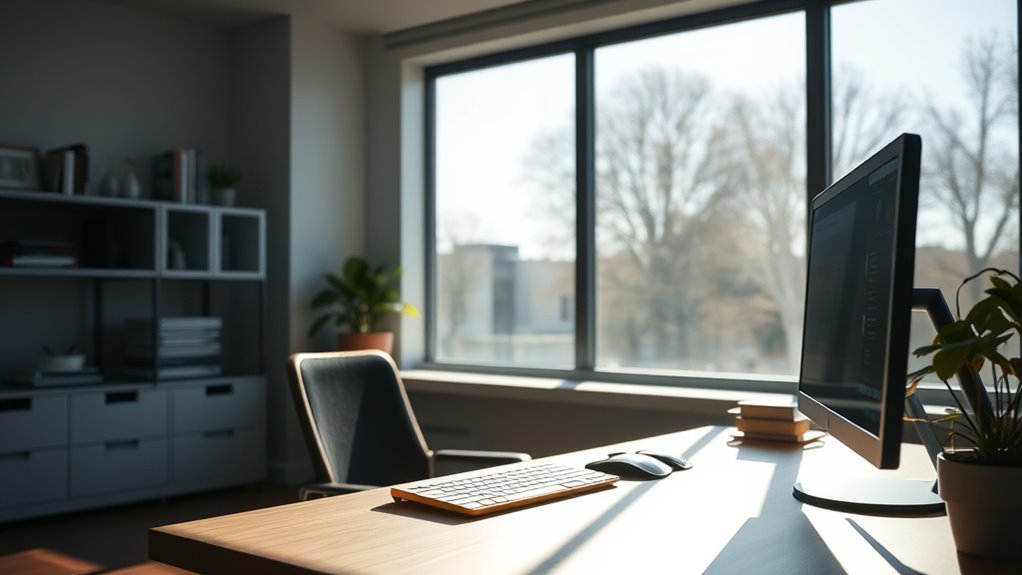
Brightness levels in your home office directly influence your alertness and productivity throughout the day. When you use adequate task lighting, you stay focused and reduce eye strain, especially during detailed work. Ambient illumination helps create a well-lit environment that prevents fatigue and keeps you energized. If the lighting is too dim, you may feel sluggish or lose concentration; too bright, and you risk discomfort or headaches. Adjusting brightness to match your activity helps maintain peak alertness. Natural light is ideal, but supplementing it with well-placed lamps ensures consistent illumination. Incorporating elements like celery juice powder or chia seeds into your diet can also support overall energy levels and cognitive function. By controlling brightness levels, you create a balanced workspace that supports sustained focus and keeps you alert from morning to evening.
Choosing the Right Light Fixtures for Your Workspace
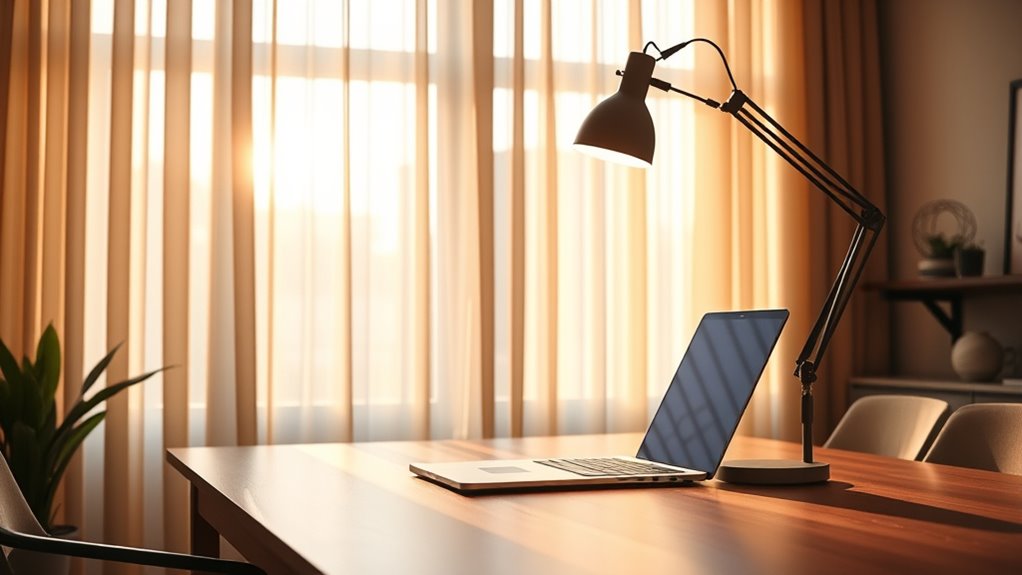
Choosing the right light fixtures is essential for creating an effective and comfortable home office. Your goal is to balance function and style, ensuring sufficient illumination without causing glare or fatigue. Incorporate decorative fixtures that complement your space and add personality. Use ambient lighting to create a warm, inviting atmosphere that reduces eye strain. Consider fixtures like pendant lights, wall sconces, or sleek desk lamps. Make sure the fixtures provide even light distribution and match your workspace’s size and layout. Avoid overly harsh or dim lighting, and prioritize fixtures that can be paired with dimmers for flexibility. Proper choice of light fixtures transforms your home office into a focused, relaxing environment that boosts productivity. Paying attention to lighting quality can significantly improve your concentration and overall comfort during work hours.
The Benefits of Adjustable Lighting for Varied Tasks
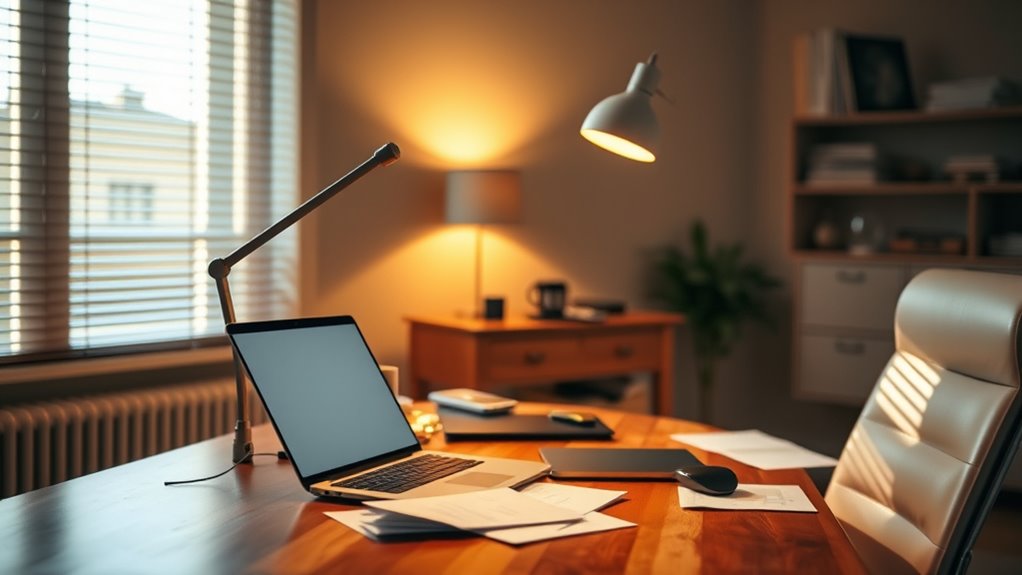
Since different tasks require different levels of illumination, having adjustable lighting in your home office offers significant benefits. Task lighting helps you focus on detailed activities like reading or writing, providing bright, direct light exactly where you need it. Ambient lighting creates a comfortable environment, reducing eye strain and enhancing overall mood. With adjustable options, you can easily switch between bright, focused lighting for tasks and softer, ambient light for relaxing or collaborative moments. This flexibility guarantees your workspace adapts to your needs, improving productivity and comfort. Instead of relying on one static light source, adjustable lighting allows you to optimize your environment for every task, making your home office more functional and conducive to focus. Incorporating lighting control can further enhance these benefits by allowing precise adjustments tailored to each activity.
Common Lighting Mistakes That Hamper Focus
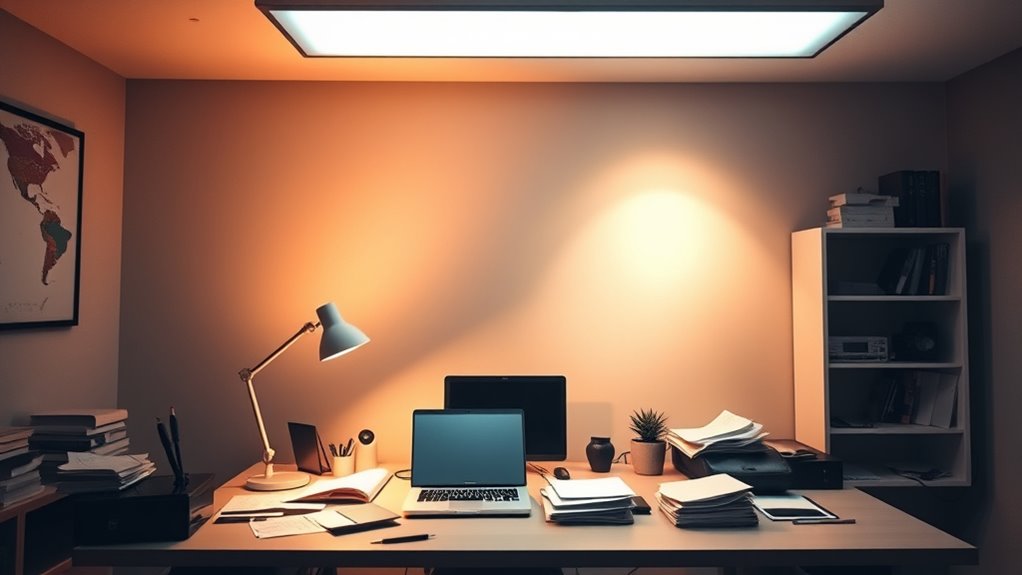
One common mistake that hampers focus in your home office is neglecting proper lighting placement, which can create shadows or glare that strain your eyes and distract you from your work. Poorly positioned lighting, especially without considering lighting aesthetics, can make your workspace uncomfortable. Using inappropriate decorative fixtures or neglecting natural light can also reduce focus. To avoid these issues, steer clear of these common pitfalls:
- Placing harsh, direct lights overhead without diffusers
- Using overly bright or dim bulbs that cause eye strain
- Ignoring the influence of natural light in your setup
- Relying solely on decorative fixtures without task lighting
- Failing to balance ambient and focused lighting for a cohesive look
- Incorporating lighting techniques that optimize both functionality and comfort, ensuring a more productive environment.
Addressing these mistakes helps create a more focused, visually comfortable environment.
Tips for Creating an Optimal Lighting Layout
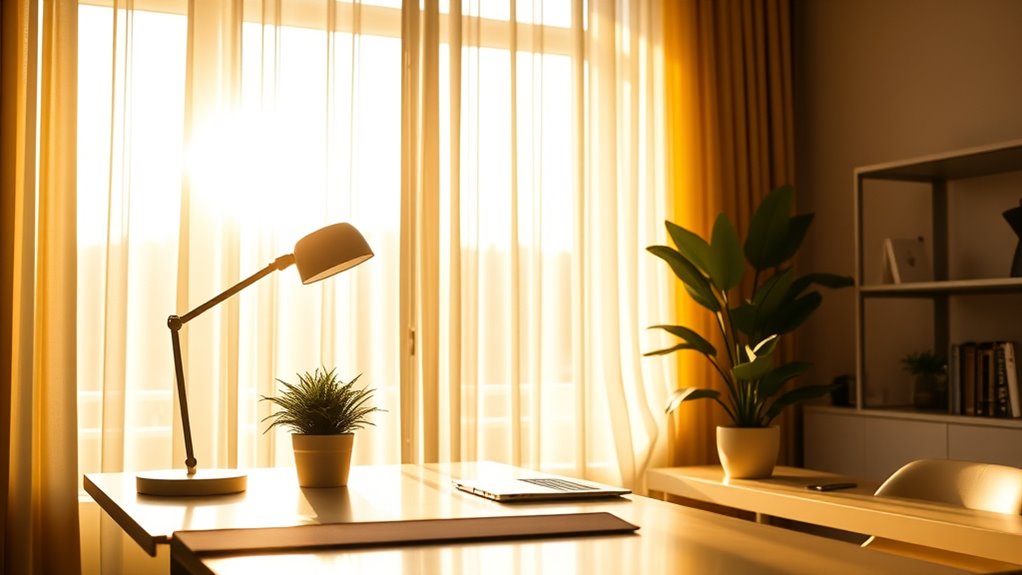
Creating an effective lighting layout in your home office involves strategic placement of different light sources to reduce shadows and glare. Position your primary light source, like a desk lamp or overhead light, to minimize harsh shadow patterns on your workspace. Use diffusers or lamps with soft, evenly dispersed light to promote light diffusion, preventing sharp contrasts that can strain your eyes. Place lights at different angles to evenly illuminate your desk and face, avoiding glare on screens. Incorporate task lighting close to your work area for focused illumination. Balance ambient and direct lighting so the room feels well-lit without overpowering brightness. Additionally, selecting appropriate lighting fixtures can enhance the overall ambiance and function of your workspace. By thoughtfully arranging your lighting, you can create a comfortable environment that enhances focus and reduces visual fatigue.
Integrating Smart Lighting for a Dynamic Home Office Environment
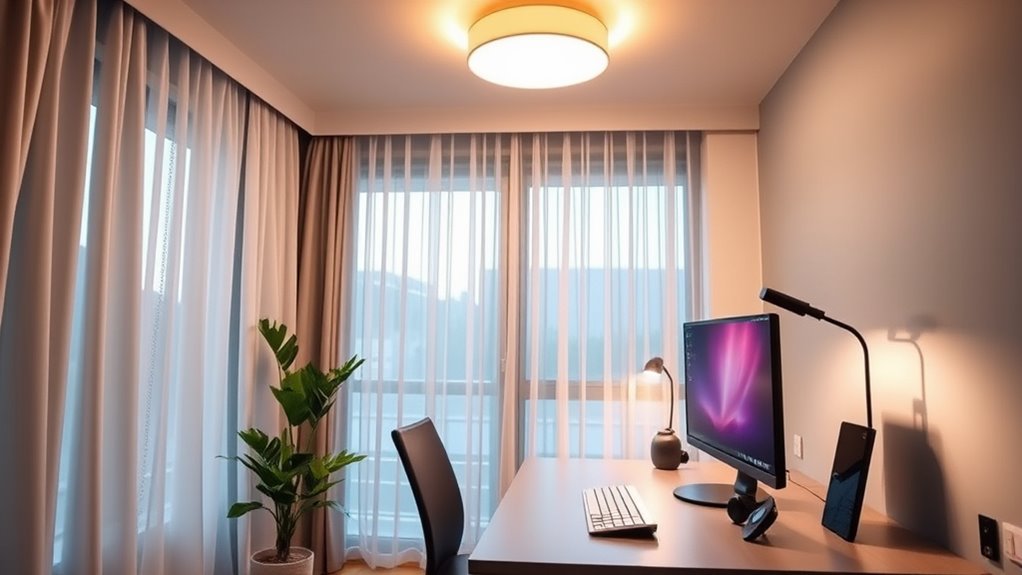
Integrating smart lighting into your home office allows you to customize your environment effortlessly and adapt to different tasks throughout the day. You can set scenes for focused work, relaxation, or meditation spaces, enhancing your productivity and well-being. Smart lighting can adjust brightness and color temperature based on your schedule or activity, creating an ideal environment when using ergonomic furniture or relaxing during breaks. With voice control or apps, you gain seamless control without interrupting your workflow. Features like timers or routine automation help maintain consistent lighting, reducing eye strain and boosting focus. Additionally, smart lighting can help you shift smoothly from work to relaxation, supporting a balanced home office experience. Proper lighting is essential for creating an inviting and functional workspace, which can significantly impact your focus and comfort.
Frequently Asked Questions
Can Specific Light Colors Improve Creativity in My Home Office?
You might find that specific light colors can boost your creativity. Using color therapy, you can incorporate ambient hues like blue for calmness, or yellow for energy and inspiration. Changing your lighting to these hues creates a stimulating environment that encourages new ideas. Experiment with different colors to see which ones resonate with you, helping to *release* your creative potential and make your home office more inspiring.
How Does Lighting Influence Eye Strain and Visual Comfort?
Lighting can feel like a hero or villain for your eyes. Proper glare reduction prevents eye strain from harsh reflections, while ideal color temperature keeps your eyes comfortable during long hours. Too bright or too cool lighting can cause headaches and fatigue, but adjusting these elements creates visual comfort. You’ll find your focus sharpens, and your eyes stay happy, all thanks to thoughtful lighting choices that support your workspace.
Are There Health Risks Associated With Certain Artificial Lighting Types?
You should be aware that certain artificial lighting, like LED lights, can pose health risks. LED flicker may cause headaches, eye strain, or migraines for some people, especially with prolonged exposure. Blue light from screens and LED bulbs can disrupt your sleep patterns and potentially harm your eyes over time. To stay safe, choose lighting with minimal flicker and consider blue light filters or glasses when using screens extensively.
What Is the Ideal Lighting Setup for Video Conferencing?
For ideal video conferencing lighting, you should focus on proper light positioning and color temperature. Place your light source in front of you, slightly above eye level, to make sure your face is evenly lit without shadows. Use a soft, natural color temperature around 4500-5500K to mimic daylight, which reduces glare and provides clarity. Adjust light angles as needed to avoid harsh shadows and create a professional, well-lit appearance.
How Can I Balance Natural and Artificial Light Effectively?
To balance natural and artificial light effectively, consider light intensity and window placement. Use natural light from windows to brighten your space without causing glare, and supplement it with soft artificial lighting to reduce shadows. Position your desk near windows for ideal light, but avoid direct glare. Adjust light intensity with dimmers or lamps to create a balanced, comfortable environment that enhances focus and minimizes eye strain.
Conclusion
By paying attention to your home office lighting, you can considerably boost your focus and productivity. For example, switching to natural light or adjustable smart bulbs can make a real difference—like Sarah, who improved her concentration by simply rearranging her desk to maximize daylight. Remember, the right lighting isn’t just about visibility; it’s about creating an environment that energizes your mind and keeps distractions at bay. Prioritize smart lighting choices to work smarter every day.
